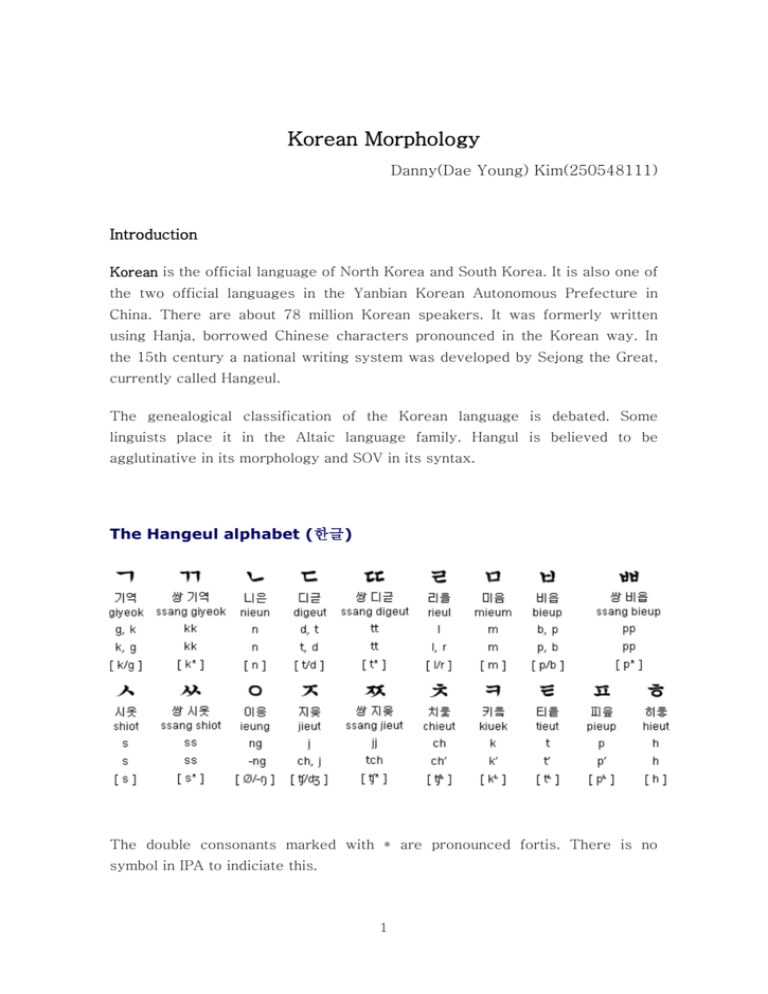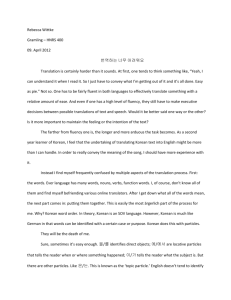Korean Morphology: Hangeul, Grammar, and Loanwords
advertisement

Korean Morphology Danny(Dae Young) Kim(250548111) Introduction Korean is the official language of North Korea and South Korea. It is also one of the two official languages in the Yanbian Korean Autonomous Prefecture in China. There are about 78 million Korean speakers. It was formerly written using Hanja, borrowed Chinese characters pronounced in the Korean way. In the 15th century a national writing system was developed by Sejong the Great, currently called Hangeul. The genealogical classification of the Korean language is debated. Some linguists place it in the Altaic language family. Hangul is believed to be agglutinative in its morphology and SOV in its syntax. The Hangeul alphabet (한글) The double consonants marked with * are pronounced fortis. There is no symbol in IPA to indiciate this. 1 Notable features of Hangeul There are 24 letters (jamo) in the Korean alphabet: 14 consonants and 10 vowels. The letters are combined together into syllable blocks. The shapes of the the consontants g/k, n, s, m and ng are graphical representations of the speech organs used to pronounce them. Other consonsants were created by adding extra lines to the basic shapes. Consonants: m, n, s, k, vs. ㅁ, ㄴ, ㅅ, ㄱ The shapes of the the vowels are based on three elements: man (a vertical line), earth (a horizontal line) and heaven (a dot). In modern Hangeul the heavenly dot has mutated into a short line. Vowel: ㅣ, ㅡ, • Spaces are placed between words, which can be made up of one or more syllables. The sounds of some consonants change depending on whether they appear at the beginning, in the middle, or at the end of a syllable. The Hangeul alphabet was invented in a systematic way. e.g. k:g, t:d, p:b vs.ㄱ:ㅋ:ㄲ, ㄷ:ㅌ:ㄸ, ㅂ:ㅍ:ㅃ, spelling=sound 2 ☺Practice ☞ Korean syllable structure is easy to distinguish. Unlike English, consonant clusters are not allowed in Korean. When it comes to stress, every vowel of the word has equal stress. e.g. [dæni]대니(cf.Danny), [hankuk]한국 / [tahanminkuk]대한민국, [kænədə]캐나다 ☞ Korean syllable structure = C(consonant) + V(vowel) / C + V + C → C + V consonant coda = C ▶cf. strike ▣part of speech ☞ When Korean word category is changed, the word form is also changed. It is noticeable that Korean predication adjective plays a role as a stative (verb). N: I have a special love for you. V: I love you. A(modification): You are a lovely lady. A(predication): You are lovely. cf. N: [saraŋ], V: [saraŋhanta], A: [saraŋsirΛn](modification), A: [saraŋsirΛpta](predication) ★ [saraŋsirΛpta]as a predication adjective plays a role as a stative (verb) (= be lovely). ☞ Korean predication adjective has some constraints on the ending of imperative, requesting sentence, passive sentence and tense. ☞Korean Verb functions as non-stative, intransitive, transitive, and ditiransitive like English verbs. ▣ agglutinative in its morphology ☞ The Korean language is considered to be a highly agglutinative language. Although Korean restricts the order of words in the way English does, its grammar imposes other types of requirements. Korean speakers should place the case markers at the end of noun and pronoun. In English, by contrast, this information is conveyed by the order of the words such as placing the subject in front of the verb(S+V+O): ► Danny ate a potato. Cf. A potato ate Danny. (English word order is very important.) Dænika kamʧalɨl mΛkΛtta.(= Danny ate a potato.) Morpheme(analyzed on the basis of morpheme) → Dæni, ka, kamʧa, lɨl, mΛk, Λt, ta. Korean case markers are like the following: (subject) -ɨn /- nɨn, -i / -ka e.g. saram(=a person)-i: namʧa(a man)-ka ☞ allomorph-depending on the final sound of the noun and pronoun 3 (indirect object) -eke / -ke (direct object) -ɨl / -lɨl e.g. saram-ɨl : namʧa- lɨl ☞ allomorph-depending on the final sound of the noun and pronoun (possessive case) -ɨj (adverb case) -ɨro /-ro e.g. ʧip(=home)-ɨro : pata(=sea)-ro (adverb case) -e ☞ English word form is more changeable than Korean. ► affix showing the past: Λt/at e.g. drink – drank – drunk, cf. masita(=drink) (basic form) – masiΛtta(=drank) ► affix showing plural: tɨl e.g. man-men, goose-geese, cf. saram(a person) - saramtɨl(people), koyaŋi(cat)-koyaŋi tɨl(cats) ► pronoun + case marker e.g. I-my-me-mine cf. na(I)-naɨj(my)-naeke(me)- naɨjkΛt(mine) CULRUTE SHAPES KOREAN MORPHOLOGY ▣ honorific / polite expression (HIERARCHICAL SOCIETY → honorific / polite expression) ► Let’s go. = Ka/kaʧa(to those who are younger than the speaker) → kapsita/kajo(to those who are aroung the same age) → kasiʧjo/kasilk’ajo(to those who are older than the speaker or have higher social status) ▣ verb ☺ To dig deeper ☞ In the case of Korean verb, it is more complicated than English verb. An interesting aspect of Korean morphology is its careful use of sentence enders. The sentence ender is very important for passing on required information about the sentence so that it can be understood. Each sentence ender must include several suffixes in a fixed order: tense, addressee honorific, mood, and sentence-type. The sentence ender tells the receiver who is being spoken to, the mood of the sentence, and the type of sentence that is given. e.g. May/might your father have caught it? = taŋsinɨj apΛʧika kɨkΛtɨl ʧap-ɨsi-Λt-ket-sɨp-nika? 4 ☞ The verb is analyzed on the basis of morpheme like the following: ʧap(=catch) = root ɨsi = polite expression to your father(the subject honor) Λt = the affix showing the past ket = the affix showing presumption / conjecture sɨp = polite expression to the listener/the partner(addressee honor) nika = the question(interrogative) affix The following diagram shows the basic combinations of sentence enders in Korean. ▣ loanwords Especially Korean has been influenced by Chinese and English. A lot of Korean noun can be replaced with Chinese. The influence of English on Korean is like the following: ■ Enlargement of Lexicon e.g. computer, rocket, robot, radio, guide, reference, rent, service, bonus, golf, etc. ■ Morphological changes ☞ interestingly Koreans use some English words in a shortened form. remote control → [rimokon], inflation → [infle], microphone → [maikɨ], combination → [kombi], amateur → [ama] ☞ Koreans have a tendency to add unnecessary Korean suffix to some English words when they speak Korean along with English words. Shocking+han(modification adjective suffix), cover+hata(verb suffix), dirty+hata(predication adjective suffix), tough+hata(predication adjective suffix) In the case of the suffix hata, it plays a role as both verb and adjective suffix. 5 ■ Semantic change ☞ The definition or the meaning of some English words has been changed. Condominium: an apartment building in which each apartment is owned by the person who lives there → hotel for tourists or vacationists ☞ Koreans try to make new words or expressions. Car + clinic → auto-repair shop / garage ■ Morphological/Syntactic changes ☞ In the past, Koreans had a tendency not to use plural suffix, passive verb, and pronoun. In the case of tense, six kinds of tenses such as present, past, future, progressive tense were usually used. However, nowadays Korean is being used in the same or similar way as English: plural suffix, passive verb, pronoun, and tense(6 → 12). ▣Blending ☞ Interestingly, some Korean people(esp. teenagers/young generation) try to make blending expressions by using both Korean and English. ʧɨlkΛwun(=pleasant) + chatting → ʧɨltiŋ ☞ When Koreans make blending expressions, the first syllable of the first word and the first syllable of the next word are merged instead of using a letter like consonant or a vowel. The University of Western Ontario → UWO Cf. Korea University → korjΛ dæhakkjo →[kodæ], Digital camera → [dika] ▣Unique morpheme ☞ There are a few Korean words which have unique morphemes like English words: cranberry, lukewarm. e.g. kamʧokkati (= restored to the former state / as good as before) sæsamsɨrupta (= abrupt / feel renewed) Complex ▣ Derivation ■ Prefix kang(=strong): kang+taʧa(a hitter) = a power hitter ʧi(=up): ʧi+patta(push) = push up am(=female): am+koyaŋi(cat) = a she-cat su(=male): su+koyaŋi(cat) = a he-cat 6 ʧam(=true): ʧam+saraŋ(love) = true love hΛt(=mis-): hΛt +tɨtta(=mishear) put(=unripe): put+koʧu(pepper) = an unripe hot pepper ■ Suffix N: -m / -ɨm: murɨm(=question), urɨm(=crying), usɨm(=smiling) Adv: -i(-kΛt, -taʧi, -sik, -ɨro/-ro, -e): kakai(=nearly), papi(=busily), sɨlpi(=sadly) V: -hata: (N→V) kongpu(=study)-hata, sarang(=love)-hata, il(=work)-hata -ita : (A→V) nulp(=wide)-ita=widen, nop(high)-ita = make higher A:-sɨrΛpta(-tapta, -lopta, -ʧita, -ʧata) : (N→A) -[saraŋ-sirΛpta](= be lovely) ☺ The following examples have no change in a part of speech when suffix is added. N→N: koʧip(=stubbornness)- ʧæŋi(= -er, a man who does) = a stubborn person V→V(+Passive meaning) ʧarɨta(=cut) → ʧallita(=be cut), purɨta(=call) → pullita(=be called) A→A: norɨ(=yellow) + sɨmhata =yellowish ■ Infix (Korean has no infix.) ■ circumfix (Korean has no circumfix.) ▣ Inflection ■ e.g. tense write = s’ɨta wrote = s’-Λt-ta will write = s’-ɨlkΛ-ta be writing = s’ɨ-koit-ta was/were wring = s’ɨ-koitΛt-ta will be writing = s’ɨ-koitɨlkΛ-ta have written = s’-Λwat-ta had written = s’-ΛtΛt-ta will have written = s’-ΛkalkΛsi-ta have been writing = s’-Λokoit-ta had been writing = s’ɨ-koitΛttΛt-ta will have been writing = s’-ΛkakoitɨlkΛ-ta ■ plural ending grammatical factor showing plural: [tɨl] 7 e.g. saram(a person) - saramtɨl(people), koyaŋi(cat)-koyaŋi tɨl(cats) ▣ Compounds(Right-headed compounds) N+N: nɨktæ(=wolf)+inkan(=human being) = a human being who has a peculiar wolf characteristic Cf. N+N(headless or exocentric compounds): paʧi(=trousers)+ ʧΛkΛri(=jacket/coat ) = a man of no guts / a good-for-nothing (fellow) N+V: him(=exertion) + tɨlta(=require) =be laborious A+N: kΛm(=black)+toksuri(=eagle), sæ(=new)+hæ(=year) Adv+ adv: palli(=quickly)+ palli (=quickly) = very quickly V+V: ʧapa(=butcher)+mΛkta(=eat) A+V: tΛrΛwΛ(=dirty)+ʧita(=become) =become dirty A+A: ʧupti(=cold)+ ʧupta(=cold) = be very cold ▣ Morphology & Phonological feature ► Generally speaking, Korean spelling matches its pronunciation though there are a few exceptions. ► some common sounds that are used in different way of, for example, initial stop consonants, which have a three-way voicing distinction in Korean vs. only two-way in English. e.g. Korean /t/, /d/, /t’/ vs. English /t/, /d/ ■ Homonym = words with different meanings which are pronounced in the same way Korean has a few homonym words, but much less homonym words than English. e.g. [pam] = night, chestnut, [nun] = eye, a bud, the division of a scale, snow ■ Homophone = words with different meanings which are pronounced in the same way but are spelled differently e. g. write and right There is no homophone in Korean. ■ Vowel harmony: Vowel harmony restricts mixing different types of vowels in one word. This characteristic appears many different Altaic languages, including Turkish, Mongolian and Manchurian. e. g. ʧap+atta (caught) vs. ʧΛp+Λtta (folded) However, in modern Korean, vowel harmony rule is no longer generally obeyed, and it appears in only certain kinds of words. 1. Words that describe sound / motion 2. Stressing adjectives 3. Particles at the end of verbs 8 ■ Reduplication: p’ang→p’apang, Generally speaking, three types have been recognized for partial reduplication in Korean: 1) Prefix type, e.g. tungsil → tu-tungsil, 2)Internal type, e.g. taling →tali-li-ng, 3) Suffixing type, e.g. cululu → cululu-lu 9 References Kang, Peom-Mo. 2009. Language. Seoul: Korean Culture Sa Publishing. Nam, Young-Shin. 2009. Traveling for Korean Language. PajuSi: Seongandang Publishing. Cho, Kyung-Sook. 2006. Aspectuality of English and Korean in a Typological Perspective. pp.81-114. Choi, Ho-Chul. 1999. Korean morphology and lexeme. pp314 – 365. Han, Kil. 1998. A comparative Description of Honorific Speech Style in Korean and English. pp. 5-31. Jeong, Yeon-Chang. 2002. The linguistic analysis on the influence of English on Korean. pp. 197- 207. Kim, Chang-sup. 1996. Achievements of and Prospects for Korean Morphology since the Liberation. Seoul Journal of Korean Studies, Vol 9, pp163-194. Kim, Hyung-Soo. 1998. A new look at Korean partial reduplication. Lim, Kyung-Sup. 2004. On the Multiple Inheritance Hierarchy System of English and Korean Predicates. The Linguistic Association of Korea Journal, 12(2), pp.145-166. Song, Chul-Ui. 1999. Morphology and phonology. pp. 287-311. Taro, Kageyama. Isolate: Japanese. pp. 512-526 http://en.wikipedia.org/wiki/Hangul http://www.omniglot.com/writing/Korean.htm 10





